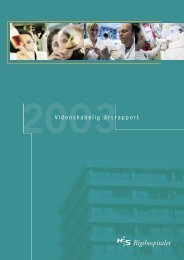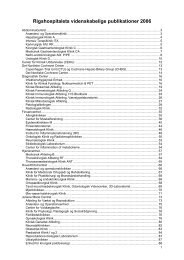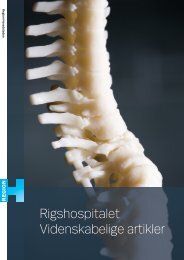View - CTU
View - CTU
View - CTU
You also want an ePaper? Increase the reach of your titles
YUMPU automatically turns print PDFs into web optimized ePapers that Google loves.
pulpotomy (34.5%) had low success rates after -1 %-year follow-up, and the vast<br />
majority of the treatments failed due to pain.<br />
The final part of the dissertation focuses on possible factors shaping endodontic<br />
treatment quality among GDPs. A factor that could explain a sub-optimal treatment<br />
quality was a low rate of adoption of new technology (such as nickel-titanium<br />
instruments, apex locators and warm gutta-percha techniques). Also the rare use of<br />
rubber dam was noted (Study IV). Other factors influencing treatment outcome<br />
investigated amongst the GDPs were their endodontic knowledge, arid their skills and<br />
attitude to various endodontic topics based on 'self-assessments'. The creation of an<br />
aseptic operation field was regarded as the most difficult procedure, whereas root<br />
canal treatment was evaluated as relatively easy and was carried out rapidly (Study<br />
II). With respect to treatment outcome the GDPs seemed to put too much emphasis<br />
on factors associated with clinical symptoms, and too little emphasis on factors<br />
related to infection condition such as 'periapical status' and 'root canal infection'<br />
(Study V). Concomitantly, the GDPs regarded the technical root filling quality as<br />
important for the outcome of the treatment (Study V). The vast majority of the GDPs<br />
rarely assessed themselves as being at a non-satisfactory level with respect to 'root<br />
canal preparation procedure' and 'root filling procedure'. The only topic where the<br />
GDPs assessed themselves as being at a non-satisfactory level was 'microbiology'.<br />
Taken togethe<br />
they should do<br />
indicated from<br />
Clinical implit<br />
deep caries c,<br />
versus a dire<br />
investigated h<br />
performed at a<br />
The 'gap' bet1<br />
found in most J<br />
0<br />
0<br />
A highe.<br />
with a i<br />
contra/Ii<br />
A grea;<br />
mandat1<br />
treatme<br />
In the interplay between the dentist and the patient, the second most frequent<br />
malpractice claim category was endodontic treatment (Study VI). The most frequent<br />
reason for sub-optimal endodontic treatments was technical shortcomings and<br />
technical treatment complications. Male dentists and female patients were overrepresented<br />
in the material indicating a sex influence on aspects of the patient-dentist<br />
communication that are important for liability claims. No specific attention was paid to<br />
the importance of an aseptic technique during root canal treatment in the available<br />
reports from the complaint boards. Thus, the focus on endodontic infection control<br />
seems not yet entirely integrated between the education platforms found within the<br />
universities in Denmark.<br />
50








